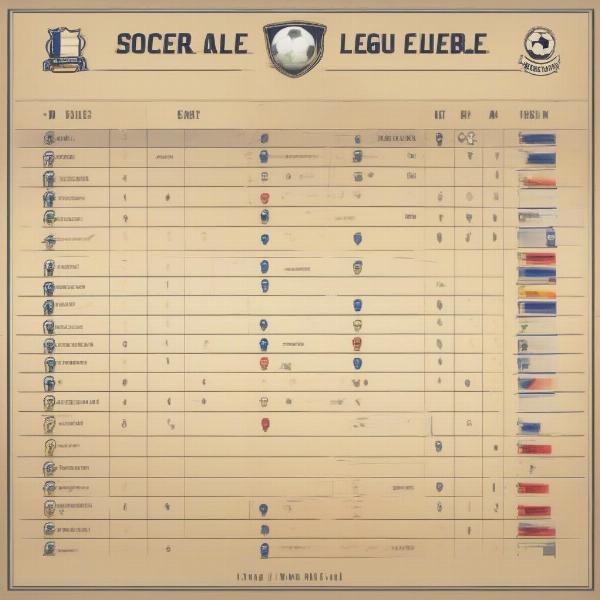The question of whether a soccer game can end in a tie is a common one, especially for those new to the sport. It’s a fundamental aspect of the beautiful game that often leads to nail-biting finishes and strategic plays. Here at Supreme Duelist Blog, we break down the intricacies of sports, ensuring you’re never left wondering about the rules. We aim to clarify even the most basic aspects for both seasoned and new fans.
Soccer, or football as it’s known in many parts of the world, is a game of two halves, and often, those halves might just leave the scoreline level. But can that happen, and what does it mean? Let’s dive into the various scenarios and rules that dictate the possibility of a soccer game ending in a tie. Here at Supreme Duelist Blog, we are committed to providing clarity on these sporting nuances for our readers. The intricacies of various rules of various sport is a topic that we are passionate about
The Basics: Yes, Soccer Games Can End in a Tie
The straightforward answer is yes, a soccer game can indeed end in a tie. Unlike some sports where a winner must be determined, a draw is a perfectly acceptable outcome in soccer. This is a key element of the sport that makes it unique. In a standard 90-minute match (plus added injury time), if both teams have scored the same number of goals, or if neither team has scored, the game ends in a tie, or draw. There’s no inherent mechanism in the normal flow of play that will break that tie, so unlike other sports, a tied result is the default if no team is ahead when time runs out.
 trận đấu bóng đá kết thúc hòa giữa hai đội sau 90 phút thi đấu
trận đấu bóng đá kết thúc hòa giữa hai đội sau 90 phút thi đấu
What Happens in Tie Games?
While a tie is a regular conclusion in many soccer matches, some competitions require a clear winner. What happens then? Here’s a breakdown:
- League Matches: In most league competitions, a tie results in each team receiving one point in the standings, while a win earns three points. This system encourages competitive play, but the draw remains a common outcome.
- Knockout Tournaments: In knockout matches, where a winner must be determined to advance to the next stage, ties cannot be the end result. In these cases, we often see a variety of tie-breaking methods, which are discussed in the next section.
Understanding the nature of tie games in soccer helps appreciate the strategy and tension that builds through games. Sometimes, both sides are just evenly matched!
Tie-Breaking Methods in Soccer: How to Find a Winner
When a tie game isn’t allowed in a tournament, such as in the FIFA World Cup knockout stage, or in the UEFA Champions League, several methods can be used to break the deadlock. Here are the main methods:
Extra Time
The first method is extra time, typically consisting of two 15-minute periods. During this additional 30 minutes, teams continue playing to try to find a winner. If there is still a tie after extra time, the match will proceed to penalty kicks.
Penalty Shootouts
Penalty shootouts are perhaps the most dramatic method of tie-breaking. Each team takes alternating penalty kicks from the penalty spot. The team that scores the most penalties out of a pre-determined number of attempts is declared the winner. Penalty shootouts can often be a test of nerves as much as of skill. It’s also, often a source of great stress for the viewers, similar to trying to understand can i shoot for sport game duke.
Away Goals Rule (Historically)
The away goals rule was previously used in some competitions, most notably in European club competitions. If a tie occurred over two legs, the team that scored more away goals would advance. This rule has been phased out in most major competitions for various reasons.
Drawing Lots (Rare)
In extremely rare situations, a winner may have to be decided by a random drawing, such as a coin toss. This method is only used as a last resort.
These methods ensure that even in situations where a clear winner is needed, the game can proceed to the next phase of the competition. Each method introduces a different dynamic to how teams approach a tied game, and can really create great viewing.
 đá luân lưu penalty trong bóng đá để xác định đội chiến thắng khi hòa
đá luân lưu penalty trong bóng đá để xác định đội chiến thắng khi hòa
Why do soccer games end in a tie?
There are a number of reasons why soccer games might end in a tie. Let’s explore some key causes.
Strong Defenses
Sometimes, both teams have very strong defenses that prevent the other from scoring. A good defence is a great way of preventing your opposition from getting through to your goal. It takes a strong attacking unit to get past a well-drilled defensive unit.
Equal Skill Level
Often, the teams are just evenly matched. This is where the fun comes in. Two teams with similar skills and playing styles are more likely to create a balanced game. Neither team may be able to dominate and gain a lead, resulting in a tie.
Tactical Stalemate
Sometimes, coaches employ very defensive tactics, resulting in a game where neither team takes too many risks. This can lead to fewer scoring opportunities and a more conservative approach, which can make a tie more likely.
The Nature of the Game
It’s simply a part of the game. Soccer, unlike some other sports, doesn’t inherently need to have a clear winner. Part of the fun is the variance that results from this. The game is structured to allow for the possibility of a tie, and in many leagues, that draw is a vital part of the overall structure and competitive balance of the game. It creates opportunities to see how teams react to a difficult scoreline, and that can be really fun to watch.
What Does a Tie Mean for a Team?
A tie in a soccer game can mean different things depending on the context. In league play, it means both teams get one point instead of the three points awarded for a win. This can have a notable impact on a team’s position in the league standings. “A draw might sometimes be just as important as a win, in terms of overall competition,” suggests expert sports commentator, Anya Petrova. “Each point gained is valuable, especially when teams are closely matched throughout a tournament or league.” In knockout tournaments, a tie can mean a long night for some teams, depending on the tie breaking method, especially if it goes all the way to penalties.
 đội bóng đá nhà ở bảng xếp hạng giải đấu, thể hiện điểm số sau khi kết thúc trận hòa
đội bóng đá nhà ở bảng xếp hạng giải đấu, thể hiện điểm số sau khi kết thúc trận hòa
Frequently Asked Questions About Ties in Soccer
Let’s tackle some frequently asked questions to further clarify this topic.
What is the most common score in a tied soccer game?
The most common tie score is a 1-1 draw, followed by a 0-0 draw. This is because, generally, teams are likely to score at least one goal. That said, we sometimes see high scoring draws, such as a 3-3 or a 4-4. A really fun game to watch, if not to experience as a fan!
Can a soccer game end 0-0?
Yes, absolutely. A scoreless draw, known as 0-0, is indeed a tie. It’s not that unusual, especially when teams are tactically cautious or if both defenses are very strong. This result can sometimes be exciting as it demonstrates the battle between tactics and defense.
Does a tie count as a loss?
No, a tie does not count as a loss. It’s a separate outcome with its own implications for the team, and the league standings. A draw neither harms nor helps a team’s win-loss record.
What are golden goals and silver goals in extra time?
Golden goals meant the game would end immediately if a goal was scored in extra time. The silver goal would end the game after the first 15-minute period of extra time if a team had a lead. Both these methods are no longer used in modern soccer.
How do ties affect the outcome of leagues?
In leagues, a tie gives each team one point, affecting their overall position in the standings. Over a long season, a run of draws can make it difficult to win a championship or to qualify for a tournament.
The Importance of Understanding Ties in Soccer
Understanding that a soccer game can indeed end in a tie is crucial for any fan. It’s a testament to the unique dynamics of the sport, which values balance and strategic play. Ties can bring their own forms of drama, tension and excitement to a game. Whether it’s a 0-0 stalemate, a thrilling 3-3 draw, or a match that goes all the way to penalties after extra time, ties are a key element of soccer and the many ways the game can unfold. In the context of major tournaments, sometimes we might all be watching to see where can i watch the usa vs mexico game and just hoping to see a winner in regulation time!
As always, Supreme Duelist Blog aims to provide useful insight into the world of sport. Whether you are a seasoned fan or a total newbie, we hope that we have answered some of your questions and given you more insight into the world of the beautiful game. Remember to check back often for more of the analysis and insight we offer here at Supreme Duelist Blog. And, if your question isn’t answered, let us know, and we’ll do what we can to help.
Conclusion
So, to reiterate, Can A Soccer Game End In A Tie? Absolutely! A tie is a fundamental part of soccer, especially in league games, and understanding this outcome is vital for any soccer fan. It impacts standings, strategic gameplay and the overall excitement of the game. We at Supreme Duelist Blog strive to bring you comprehensive knowledge on all aspects of sports. We hope this article has clarified the nuances of tied soccer games for you. Join our community for more in-depth analysis and insights into the world of games and sports.
Leave a Reply